Archive for the 'Uncategorized' Category
June 10th, 2014 by dave dorsey

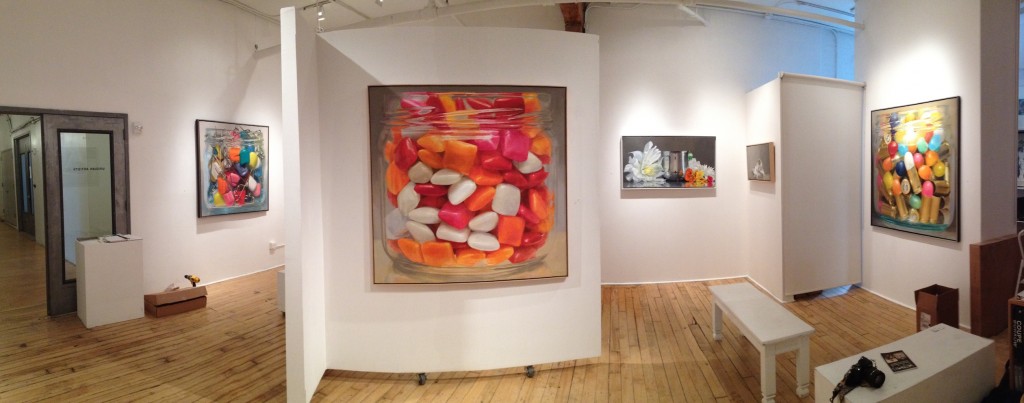
“Polarities”, my solo show at Viridian Artists, opens today. These are a couple shots I took after Lauren Purje and I hung the paintings on Sunday. It’s amazing how many emergency measures need doing at the last minute: one entire frame came apart at all four corners and had to be more or less reassembled securely, which we succeeded in doing, after a few false starts. I had to take another painting out of its frame, and off the stretchers at two corners, in order to tighten it, then reattach the frame. One other painting also had to be tightened, through less drastic measures involving a hair drier we bought on 10th Ave. at a drug store. I brought most of the other tools we needed, anticipating problems before I left Rochester, and Lauren provided the rest. There was a sense of fun in all of it, since so much work over the past five years had gone into making the work itself–any surprises in the delivery and hanging of the work seemed minor problem-solving exercises, rather than real work. Even though I drove the paintings 350 miles in what a friend called a “soccer mom” mini-van I rented from Avis. I informed her that it’s well known how Picasso lugged canvases to Paris in a Dodge Caravan. Really! (However, Van Gogh drove a Saab to Arles.) Here’s a video which I stupidly took in portrait aspect, offering what looks to me now like a keyhole view of the whole show. Reception is Thursday at 5:30 p.m. William Benton will perform on guitar.
June 10th, 2014 by dave dorsey
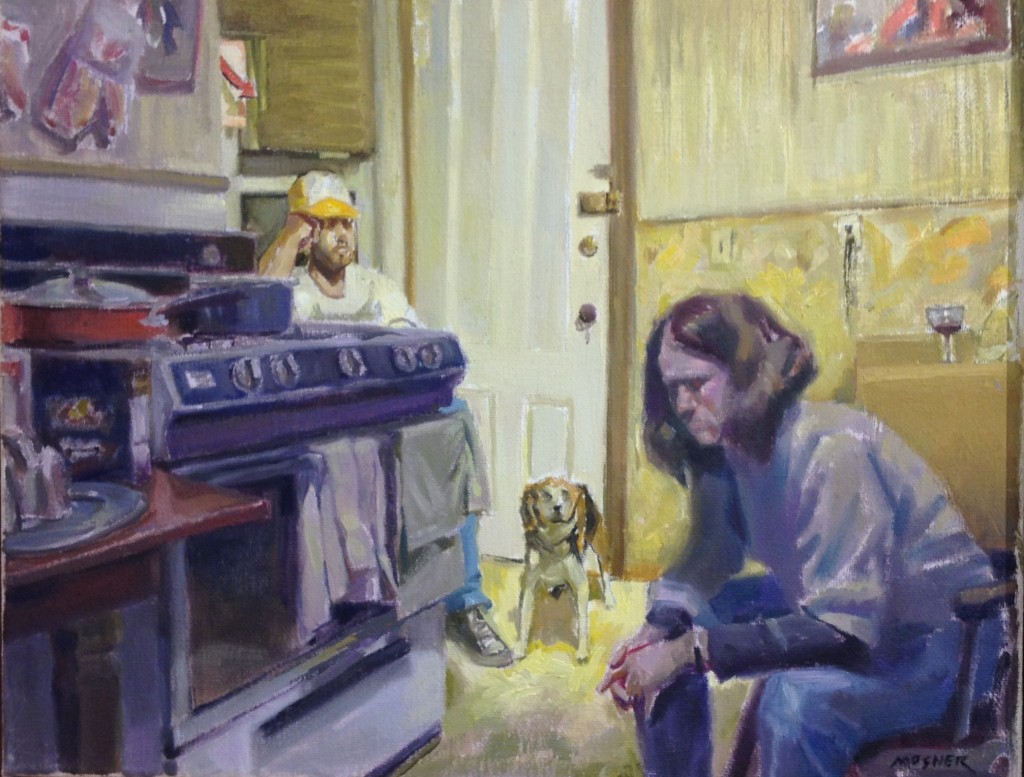
Same As It Ever Was, Daniel Mosner, oil on canvas
From Proverbs and Commonplaces, Oxford Gallery, Rochester, NY.
June 8th, 2014 by dave dorsey

Gatherer, Doug Whitfield, oil on canvas
A bird in the hand from From Proverbs and Commonplaces, Oxford Gallery, Rochester, NY.
June 6th, 2014 by dave dorsey

RICKY: It was one of those days when it’s a minute away from snowing. And there’s this electricity in the air, you can almost hear it, right? And this bag was just… dancing with me. Like a little kid begging me to play with it. For fifteen minutes. That’s the day I realized that there was this entire life behind things, and this incredibly benevolent force that wanted me to know there was no reason to be afraid. Ever. Video’s a poor excuse, I know. But it helps me remember… I need to remember…
Now Jane is watching him.
RICKY (distant): Sometimes there’s so much beauty in the world I feel like I can’t take it… and my heart is going to cave in.
***
LESTER: I had always heard your entire life flashes in front of your eyes the second before you die. First of all, that one second isn’t a second at all, it stretches on forever, like an ocean of time… For me, it was lying on my back at Boy Scout camp, watching falling stars… And yellow leaves, from the maple trees, that lined our street… Or my grandmother’s hands, and the way her skin seemed like paper…And the first time I saw my cousin Tony’s brand new Firebird… And Janie… And …Carolyn.
I guess I could be pretty pissed off about what happened to me… but it’s hard to stay mad, when there’s so much beauty in the world. Sometimes I feel like I’m seeing it all at once, and it’s too much, my heart fills up like a balloon that’s about to burst……and then I remember to relax, and stop trying to hold on to it, and then it flows through me like rain and I can’t feel anything but gratitude for every single moment of my stupid little life…(amused) You have no idea what I’m talking about, I’m sure. But don’t worry…
You will someday.
–script for American Beauty
June 4th, 2014 by dave dorsey
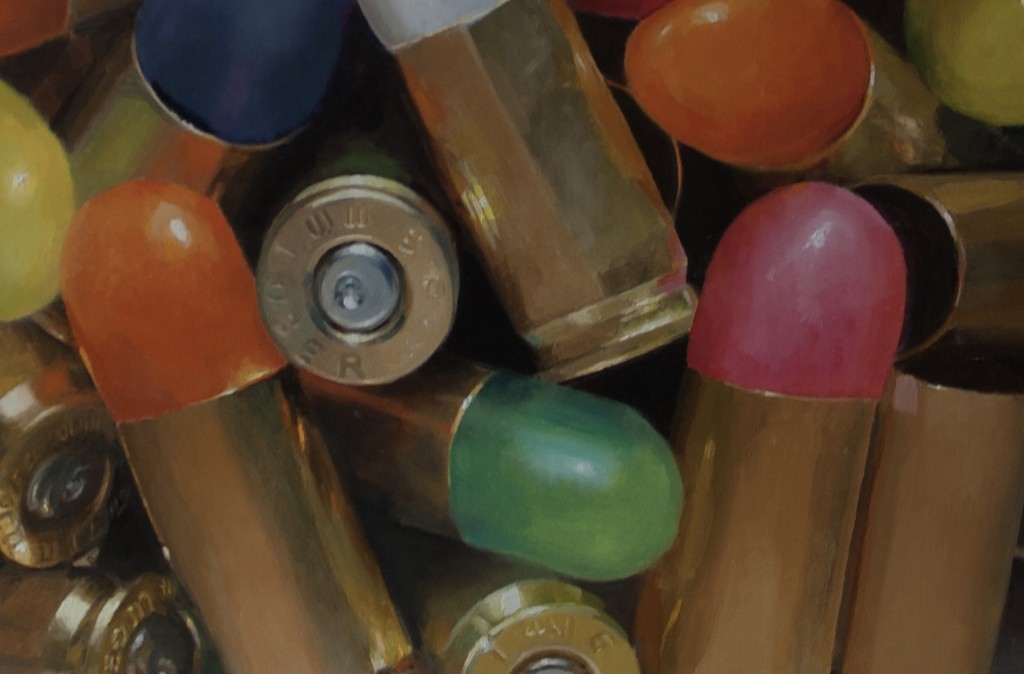
Treaty: Jelly Bean Bullets, detail, oil on linen
It just occurred to me I ought to post this, since it’s about me and my solo show opening in a week at Viridian Artists. Blogs are so much work; you have to, like, stay on top of everything. Yellow Tail will be served. Cat Casual will play guitar, which is why I’ll be showing up.
DAVID DORSEY “Polarities: No Ideas But In Things”
JUNE 10 – JUNE 28, 2014, Reception, Thursday, JUNE 12, 6 – 8 pm.
In his first solo in his three years as a member at Viridian, David Dorsey’s painting dwells on humble objects or commonplace scenes that bear little conceptual weight, yet in the way they come together for this exhibit, he shows how they can evoke life’s vital oppositions: life and death, dark and light, innocence and experience. Each individual painting, considered alone, represents an exploration of purely perceptual concerns, exploring how all the most traditional elements of painting—light, color, form, and the physical quality of paint—can trigger an immediate apprehension of life as a whole, in ways that words can’t reach.
“I like to focus on things and moments that might be so common, they’re taken for granted, so that you have a fresh impression of what you might see every day,” he says. “Jelly beans. A white clam sauce jar. A cheap stainless steel cream pitcher I bought at Wegman’s. Dahlias I grow for next to nothing by wintering the tubers in my basement and replanting them every spring. The skulls would otherwise be sitting in a box forgotten, somewhere in a college lab. The diaper pins I store in the clam sauce jar. But bullet casings you can buy in bulk from Etsy.”
Completed over the past five years, these eighteen paintings express basic oppositions, sometimes ironically, sometimes literally. The ideas are secondary and usually arise after the work is done. In choosing subjects, Dorsey is concerned with perceptual qualities. As William Carlos Williams put it, “No ideas but in things.” Dorsey lives and works in upstate New York, has shown his work extensively in the U.S. as well as in Europe. He has won various awards, and his work is represented in collections throughout the U.S. He writes regularly about art at www.thedorseypost.com. Manifest has published his criticism.
“Eggplant and Bok Choy” and “Still Life with Pocket Door” are painted so vividly with almost unreal, vibrant colors that they seize viewers’ attention, enticing with beautiful freshness. The living is cast against the long departed with his third painting, “Skull Unearthed Circa 1930,” a stark work of a pale room washed in clean light with a weathered skull propped atop a cardboard box. The quietude of the work is enhanced greatly by the single black audio speaker sitting silently on a shelf and the nearly toothless, gaping maw of the human remains. —Rebecca Rafferty
In David Dorsey’s “Skull Unearthed Circa 1930″, the shipping box, scribble-marked “actual human skull”, presents the decapitated human remains in the . . . incongruous setting of a breezy open spring window. Study the sockets and cavities of the sculpted toothless mandible as the artist did in an intricately painted, multiple ridged landscape. One . . . is engrossed in the painter’s facility and fascination with his subject. –Marline Steel, AEQUI
June 2nd, 2014 by dave dorsey
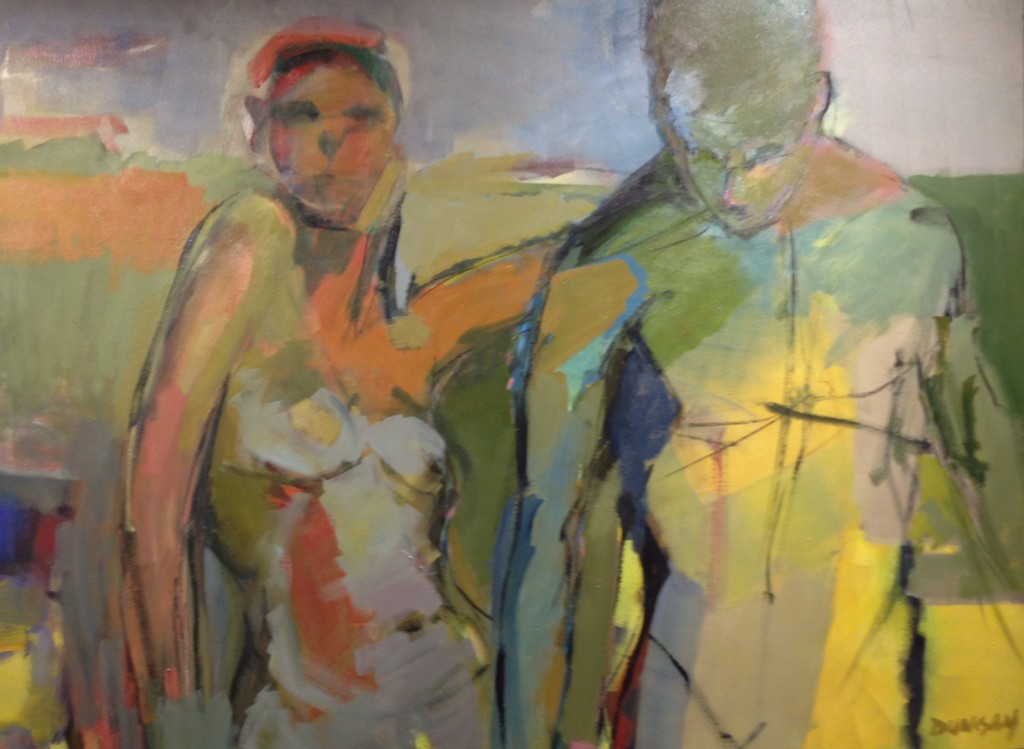
Worlds Apart, The Urbanites, detail, Anthony Dungan, oil on canvas
From Proverbs and Commonplaces, Oxford Gallery, Rochester, NY.
May 30th, 2014 by dave dorsey
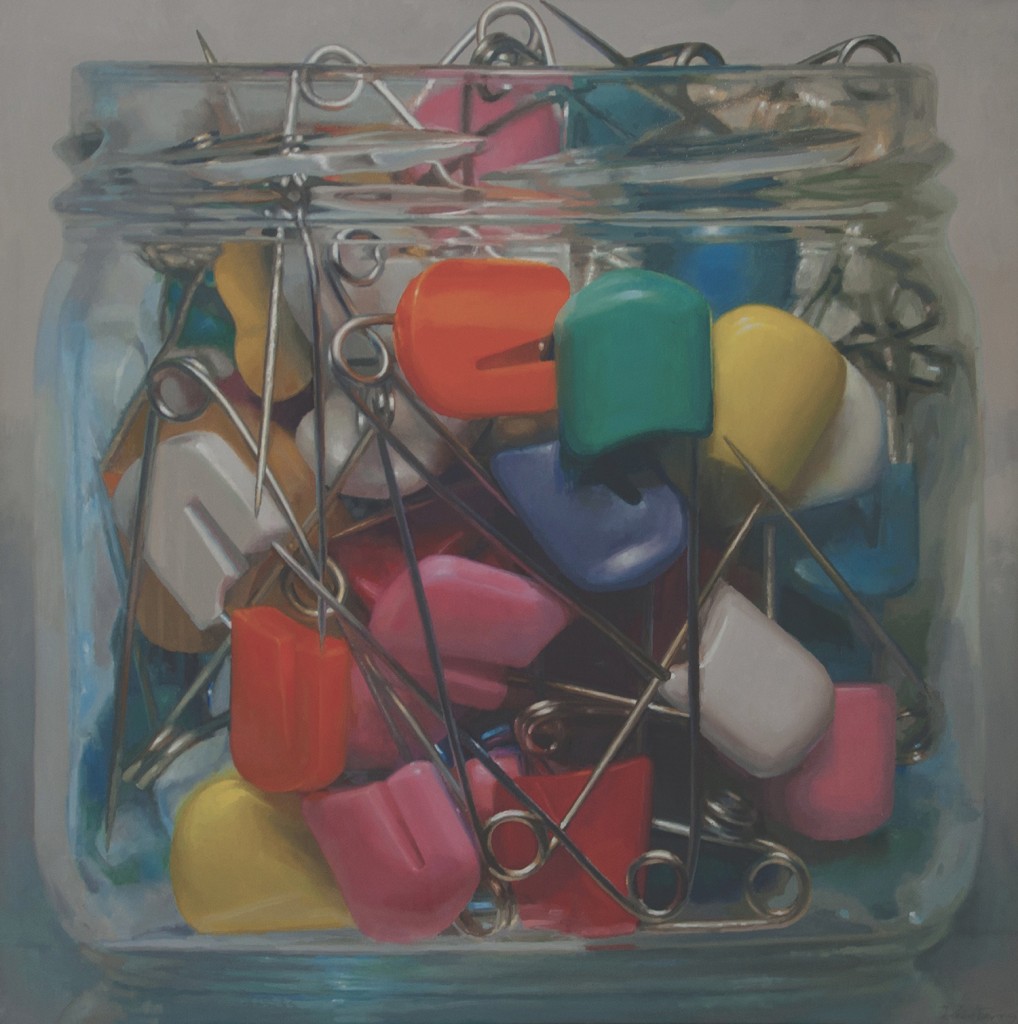
Breaking Free, Cutting Loose, oil on linen
In painting, it can be hard to keep the cart behind the horse. For me, normally, paint comes first and everything else follows along behind. There are many ways to be clever and cerebral with a work of art, and most of them lead away from the subconscious drive to paint—a painting can too easily become a dutiful illustration of an idea. In my solo show in a couple weeks at Viridian Artists, entitled Polarities, I was drawn toward an idea of contraries as a basis for juxtaposing one kind of painting with another—or opposite principles within a single image. I arrived at the title and theme by looking at the work I’ve done over the past five years or so and seeing oppositions everywhere in the way I’d painted—in ways I hadn’t consciously registered while I was doing the work. At that point, I started working on some ideas for a few more paintings to complete the show. I was letting the idea of polarities serve as a basis for creating images that would fit, neatly or not, into the theme. For some people, this would be an occasion for applause, paintings that have “something to say”, work with a conceptual dimension, but I saw it as a Faustian bargain. Clever often means contrived. For the most part, though, the concepts here followed the work, sitting obediently in that cart securely behind the urge to paint.
I did one painting, Treaty: Jelly Bean Bullets, after coming up with my theme, though it took me weeks to arrive at the title. I kept stapling little notes at the crest of my easel’s middle strut, just above the upper edge of the painting, each note bearing a fresh, potential name. Armistice, no, Gun Control, no. Cease fire. Ugh. At first I was going to pair one of my candy jars with a jar full of empty Luger shell casings I found at Etsy, where they’re available in bulk as a craft supply for people making “steampunk jewelry.” Leave it to the Internet. I did a study or two of the empty shells and then at some point I saw how easily MORE
May 29th, 2014 by dave dorsey
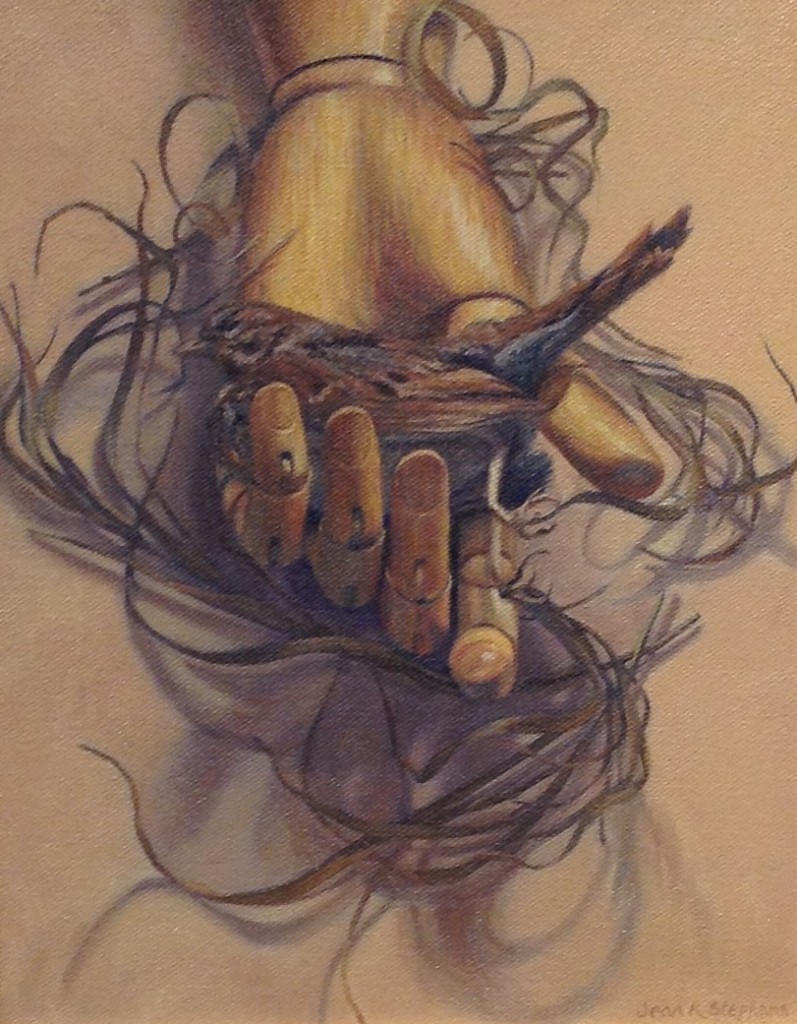
Bird in Hand, Jean K. Stephens, oil on canvas
From Proverbs and Commonplaces, Oxford Gallery, Rochester, NY.
May 27th, 2014 by dave dorsey
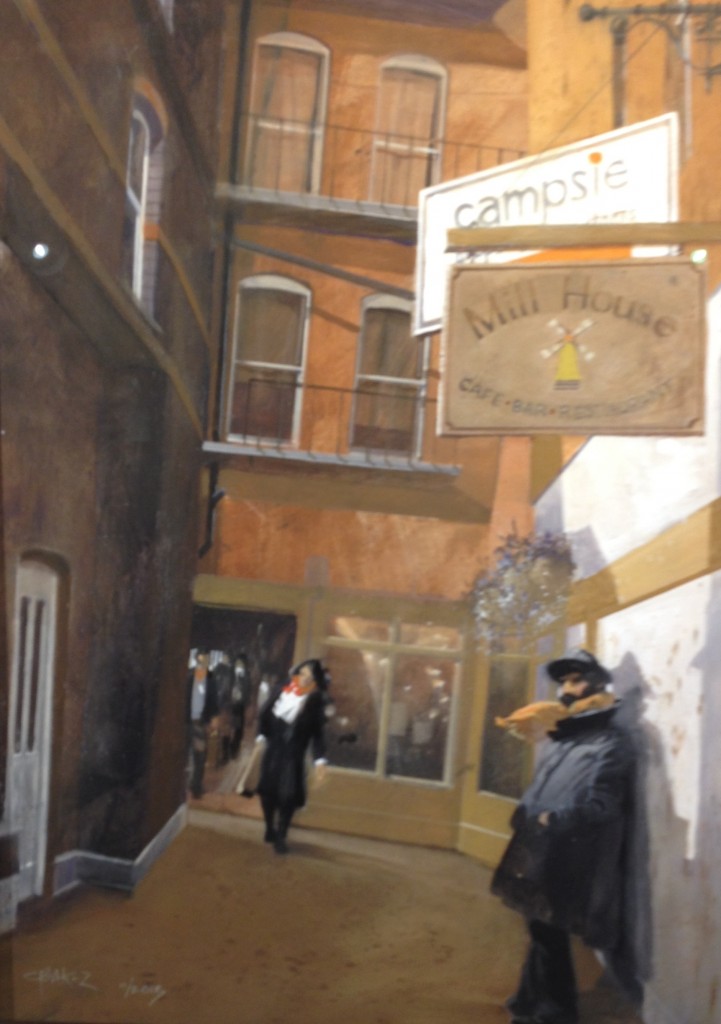
Join the Crowd, Chris Baker, gouache
From Proverbs and Commonplaces, Oxford Gallery, Rochester, NY.
May 25th, 2014 by dave dorsey

Dostoevsky
The novels of Herman Hesse were a hot item in the 60s, with their romanticism, their mix of Jungian psychology and Eastern mysticism and their hippie-friendly dreaminess. I read most of them when I was in high school. I loved the opening of Steppenwolf, the yearning of Harry Haller, the depressed, cerebral, central figure who takes a room in a clean, well-lighted boarding house and lingers on the stairs admiring the cleanliness and order of the home’s little windowed corners, all the attention devoted to middle-class comfort and restraint. He loved it because it was a levee against the tide of darker impulses and brooding that pulled him, throughout the book, toward a pyschologically liberating and dangerous life on the margins of respectability. Its tension between the passion for order and normalcy and the imaginative pull of the unpredictable is how the book fascinated me years ago when I read it. The other night, in an email, I read a quote from Mark Twain, sent from an acquaintance–“Be good and you will be lonesome.” It reminded me of Dostoyevsky’s Prince Myshkin, who was so good he simply uttered whatever he thought, without calculation, always telling the truth, or what appeared to be the truth to him, and the most fundamental truth he uttered was that “beauty will save the world.”
So I did a search for Prince Myshkin to refresh my memories about him and came across an out-of-print essay about him from Hesse, who was deeply influenced by Dostoevsky. To my surprise, it led me toward Hesse’s notion of polarity and how Myshkin himself was a figure who reconciled polarities by being rooted in something more fundamental than the world of opposites (in a Joseph Campbell kind of way). As Hesse puts it, about a scene where the prince is rejected by everyone around him:
On the one side society, the elegant worldly people, the rich, mighty, and conservative, on the other ferocious youth, inexorable, knowing nothing but rebellion and hatred for tradition, ruthless, dissolute, wild, MORE
May 23rd, 2014 by dave dorsey
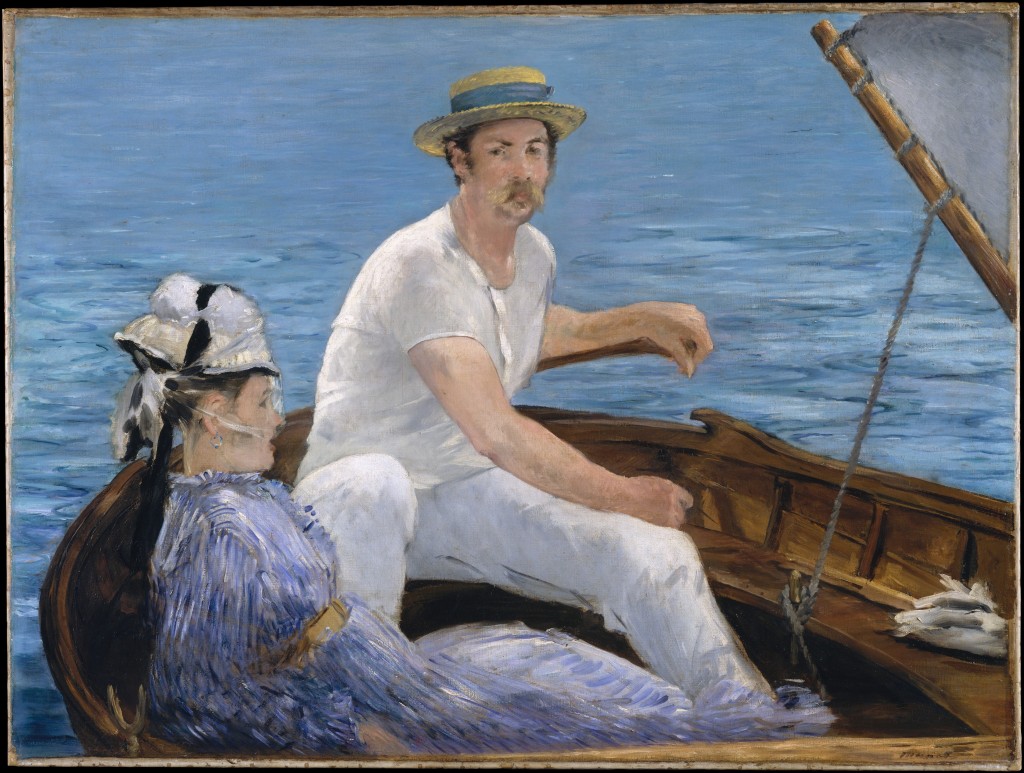
Boating, Edouard Manet
The Metropolitan has joined in the trend championed by Google, Getty and the National Gallery and has uploaded 400,000 images of art for free public viewing, with resolutions fine enough to give you a “feel” for the surface texture. So quit taking pictures of permanent collections and just look while you’re there. As with Google’s art project, the photography is so good you can see much of what was only available by looking at the actual work, except for a sense of scale.
May 21st, 2014 by dave dorsey
 This is a great guide for buying good art that’s far more affordable than what gets traded at the air fairs in one particular city–Toronto, just a hop across the lake for us in Rochester. It’s a great point-by-point argument for buying art that represents a choice between a good painting and a new high-end flat-screen TV. That’s no Sophie’s Choice.
This is a great guide for buying good art that’s far more affordable than what gets traded at the air fairs in one particular city–Toronto, just a hop across the lake for us in Rochester. It’s a great point-by-point argument for buying art that represents a choice between a good painting and a new high-end flat-screen TV. That’s no Sophie’s Choice.
May 19th, 2014 by dave dorsey
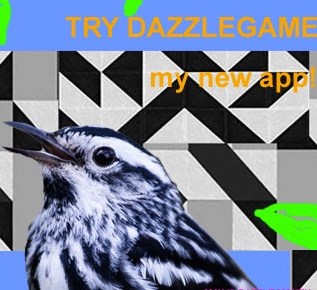
Dazzle, Jim Mott’s new app
My friend Jim Mott came by a little while ago to discuss painting, “Tim’s Vermeer,” marriage, money, the uncanny behavior of birds, and an app he invented and created with the help of his partner, Bruce Campbell. A few days later, as a follow-up, he introduced me to a spot on the southern shore of Lake Ontario where you can see a dozen kinds of warbler in the course of an hour. They congregate there, biding their time before flying across the lake into Canada, maybe waiting for it to warm up enough to justify the effort. I photographed half a dozen warblers, a thrush I’d never seen before, a screech owl, a Lincoln sparrow and a couple catbirds. It was my first “birding” excursion, aside from climbing out of my TV-viewing chair to get a shot of a bird on our birdbath in the backyard.
The bird talk wasn’t completely unrelated to what he came to demonstrate: the game he made, called Dazzle, which is for sale on iTunes. It was designed with a couple disparate things in mind: the markings of a black and white warbler–which we saw in the woods a few days later–and the nautical camouflage used in World War I, called dazzle. Playing the game is simple: you try to rotate diagonal black-and-white squares to either match up colors for yourself or avoid matching them for your opponent. Points are assigned based on the number of matches. The level of simplicity is somewhere between Tic Tac Toe and Minesweeper. The game offers a virtual roll of dice to determine which square you have to rotate, and you can either play against the app or against another person.
“One of the things I like about it is that you can do something else intelligent, like have a conversation, while playing it,” he said.
Since Jim’s project, as an artist, is to take money out of the picture when it comes to art–traveling around the country and staying with people overnight in exchange for a painting of their surroundings–this app represents a very minor equivalent to a grant application or tenure for other artists. In other words, income not related to art sales. He created it to inspire the competitive urge, but also to give players a chance to get fascinated enough with the patterns they’re creating to quit caring who wins. That would be a nice principle to see applied to a lot of other activities. I bought it. It’s fun. Better yet, it’s like a donation to a Kickstarter campaign, without the Kickstarter.
May 18th, 2014 by dave dorsey
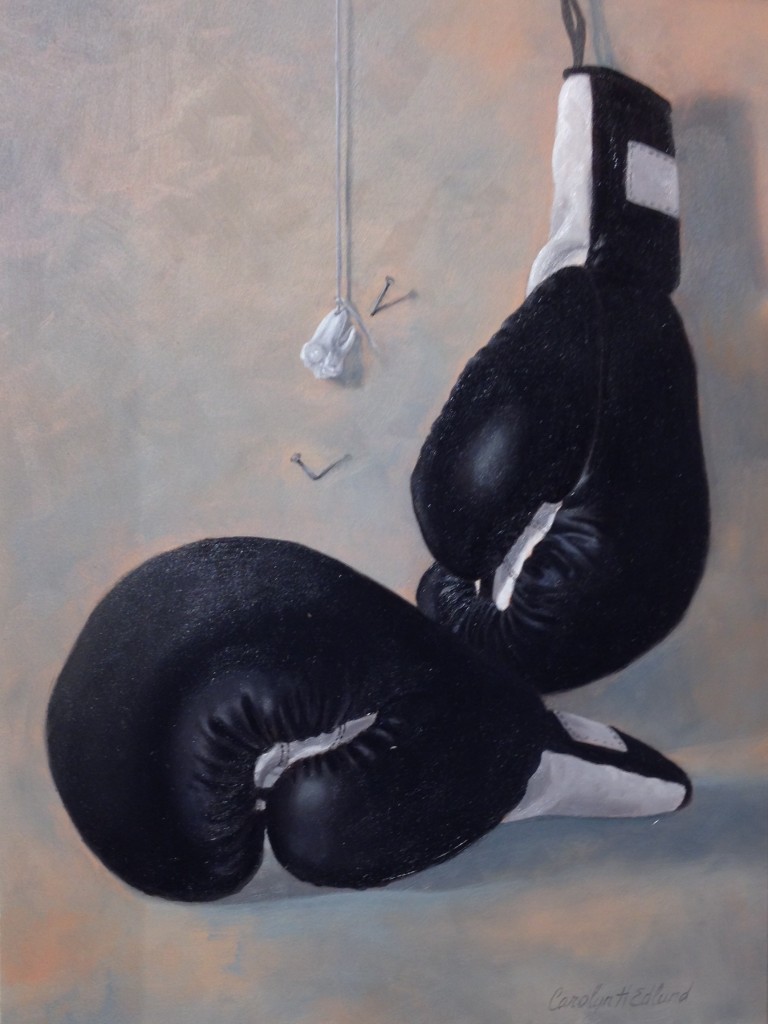
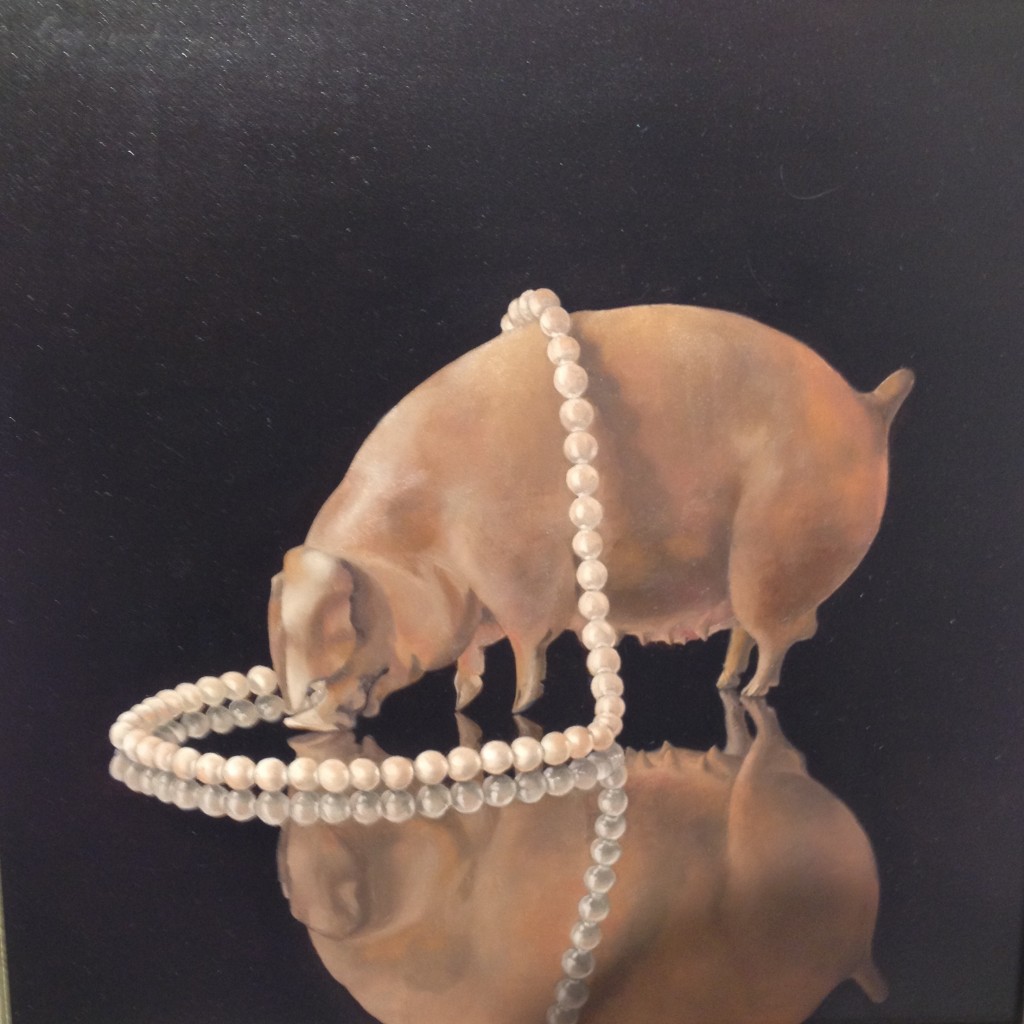 More from Oxford Gallery’s “Proverbs and Commonplaces” exhibit. Carolyn Edlund’s Fighting Tooth and Nail and Pearls to Swine.
More from Oxford Gallery’s “Proverbs and Commonplaces” exhibit. Carolyn Edlund’s Fighting Tooth and Nail and Pearls to Swine.
May 17th, 2014 by dave dorsey
 A first-ever collaboration is being staged at Ceres Gallery on May 24 at 4 p.m.: Vernita Nemec will perform in honor of under-recognized artists backed by the improvisations of Cat Casual’s William Benton, the singer and guitarist from Shilpa Ray and Her Happy Hookers. Vernita, our director at Viridian Artists, has presented her performance art as Vernita N’Cognita, in honor of unknown and uncelebrated artists, in the United States, Hungary, Japan, Ireland, Germany, Mexico and France, including performances at the Pompidou Museum in Paris and Documenta 13 in Kassel.
A first-ever collaboration is being staged at Ceres Gallery on May 24 at 4 p.m.: Vernita Nemec will perform in honor of under-recognized artists backed by the improvisations of Cat Casual’s William Benton, the singer and guitarist from Shilpa Ray and Her Happy Hookers. Vernita, our director at Viridian Artists, has presented her performance art as Vernita N’Cognita, in honor of unknown and uncelebrated artists, in the United States, Hungary, Japan, Ireland, Germany, Mexico and France, including performances at the Pompidou Museum in Paris and Documenta 13 in Kassel.
Cat Casual, a Queens instrumentalist and singer from Oklahoma, now with Shilpa Ray, has worked with a long list of luminaries: Nick Cave, Bonnie “Prince” Billy, Makoto Kawabata (Acid Mothers Temple), Steve Shelley (Sonic Youth), Steve Wynn (Dream Syndicate), Ivan Julian (The Foundations, Richard Hell and the Voidoids), and many others as well as sharing the stage with many legendary performers of the past and present. He is grooming his solo band, Cat Casual, for live shows in the near future. Most recently, he contributed original music for a production of Marius Von Mayenberg play The Ugly One which was performed at The Bridge Theatre.
May 14th, 2014 by dave dorsey
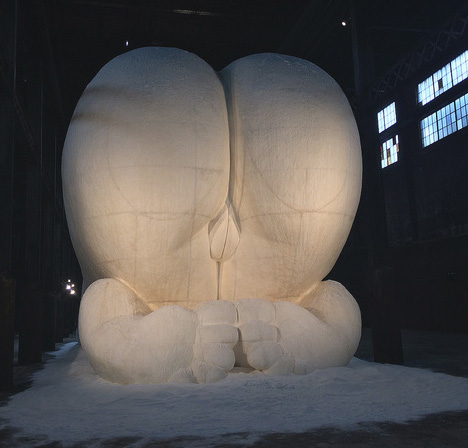
Kara Walker’s Subtlety, elevator butt view, photo courtesy Hrag Vartanian
Some throw-away thoughts that arose randomly in response to the Hyperallergic’s excellent reflections (and photography) of Kara Walker’s new 35-foot-tall installation. It’s a striking feline berm of polystyrene coated with 80 tons of sugar, configured as a Sphinx. It’s called A Subtlety, or the Marvelous Sugar Baby, and it’s sitting inside Brooklyn’s deteriorating Domino Sugar Factory, now scheduled for demolition.
First, I thought of some Irish poetry:
1. . . . a vast image out of Spiritus Mundi/ Troubles my sight: a waste of desert sand;/A shape with lion body and the head of a man,/ . . . what rough beast, its hour come round at last,/ Slouches towards Bethlehem to be born? –W.B. Yeats
2. Thus having been put in mind of sphinxes that herald the apocalypse, or at least the end of factories as we know them, it struck me that if Subtlety were to start dating, after her performance in Williamsburg is up, her perfect match would be the equally apocalyptic Stay Puft Marshmallow Man, from Ghostbusters. They’re perfect for each other. They’re both enormous (weight issues would be off the table), made of sugar, very very white and they both bring intimations—at least for those with Yeats on the brain—of uprisings and/or end times. My only caveat for Stay Puft would be that he may be a big old sailor on leave and probably has seen more than his share of bad-ass ports, but the sweetness on offer here is only skin deep. Underneath she’s got a hard core of polystyrene. And, in turn, Subtlety should keep in mind that her hook-up is highly flammable. Aside from that, a one-in-a-million match.
3. Tired of bein’ lonely, tired of bein’ blue,
I wished I had some good man, to tell my troubles to
Seem like the whole world’s wrong, since my man’s been gone
I need a little sugar in my bowl,
I need a little hot dog between my roll. —Bessie Smith
4. Any cat lover, or simply cat observer, will recognize her pose as “elevator butt.” This is a term I discovered on YouTube after recognizing it from experience and trying to find a name for it. While being stroked affectionately on the back, or when ready for sex, a cat will raise its tail this way and expose itself. So this is a cat that’s either happy or about to be very very happy. It’s taking control of other cats in the time-honored way that women have taken control of men through the ages. The way sugar babies control sugar daddies. So, as if it weren’t enough to be an apocalyptic sphinx, this cat rules as they all do.
5. The last shall be first. An image explicitly honoring slaves by depicting a racial stereotype in a figure that represented, in Egypt, the fusion of god and humanity, would seem to indicate that Walker wants to celebrate how those who were last and lowest, a century and a half ago, now have the opportunity to be first and at the top of their chosen food chain. A visage that belonged to Aunt Jemima now adorns a figure that seems to demand worship, or obeisance, or at least some down-home adoration. The tips of a sweat-absorbent kerchief become the ears of a cool cat. The election of Barack Obama and the sale of Dr. Dre’s brand for $3 billion to Apple would be just two examples of how at least some members of a once enslaved race now can pretty much achieve anything they like in a way very few people can. There is a long list of others who have proven this to be true. (Some of us would like to reserve the right to wish for the old days when Dre was simply one of the most unique and minimalist DJs in hiphop who knew his way around an actual beat like few others.)
6. This turning of the tables, how the lowly can rise up into a position of power, the former slave becoming a master, put me in mind of Kurt Vonnegut’s Player Piano, of all things. It was a novel about a dystopia in which most work had been mechanized and automated. The machine is the ultimate slave yet the labor it offers increasingly displaces more and more human workers. What once simply served us, now usurps the role we once had and leaves us, like the children with their baskets of token sweets in Walker’s installation, wandering aimlessly and unemployed in the terrain it controls and harvests. The rule of technology would indeed be a sphinx worthy of W.B.’s poem, The Second Coming, though I doubt that Walker had this kind of reversal in mind, leaving aside the question of whether her image can stand as an emblem of it regardless of her intent.
7. Does artistic intent matter? Should it determine what effect a work has on a viewer? I like ideas that arise out of some visceral struggle with basic formal challenges. You want to pair something monochrome and cold and shiny against something soft and colorful and bright and you end up representing objects that enable you to do this and, maybe all those shapes cohere in a visual way. Sometimes, on top of that, you end up with another kind of coherence. A painting of, say, open diaper pins becomes an emblem of moral choice, a way of behaving, an outlook on life, once you step back and start thinking about it. None of this needs to be in the mind at the start of the process; only a desire to achieve a particular visual quality. But maybe an idea arises as you feed that impulsive, instinctive appetite to see certain colors and shapes appear on a field of white. Personally, I want to make paintings that have nothing to say, but evoke a world, a unity, a whole. If they imply more than I had in mind, fine. Yet I like Walker’s installation, as intentionally conceptual as it appears to be. It does all I ask: it makes me want to keep looking at it. I mean, who am I to say no to something that big? It makes me wonder if she had an idea of a sphinx lurking in the back of her mind for a long time and finally found the place to make it come alive, without any ideas associated with it, or did she come up with it only after being offered the space? Even better, did the sphinx not occur to her until she had sketched a hilly mound of abstract sugar, with its eskers and kames, and then she thought: hey, that could be the haunch of a cat! Better yet, a sphinx! And she went on from there. I’d love it if that were the case, because that for me is how art ought to come about. It starts as a subconscious pull, like love, towards certain instinctive physical choices, certain formal qualities, and in the effort to make a whole out of many disparate parts, something else happens. It all comes together somehow, and you’re surprised by what your mind has led you to do, even if it didn’t bother to enlighten you, along the way, about where you were headed.
May 13th, 2014 by dave dorsey
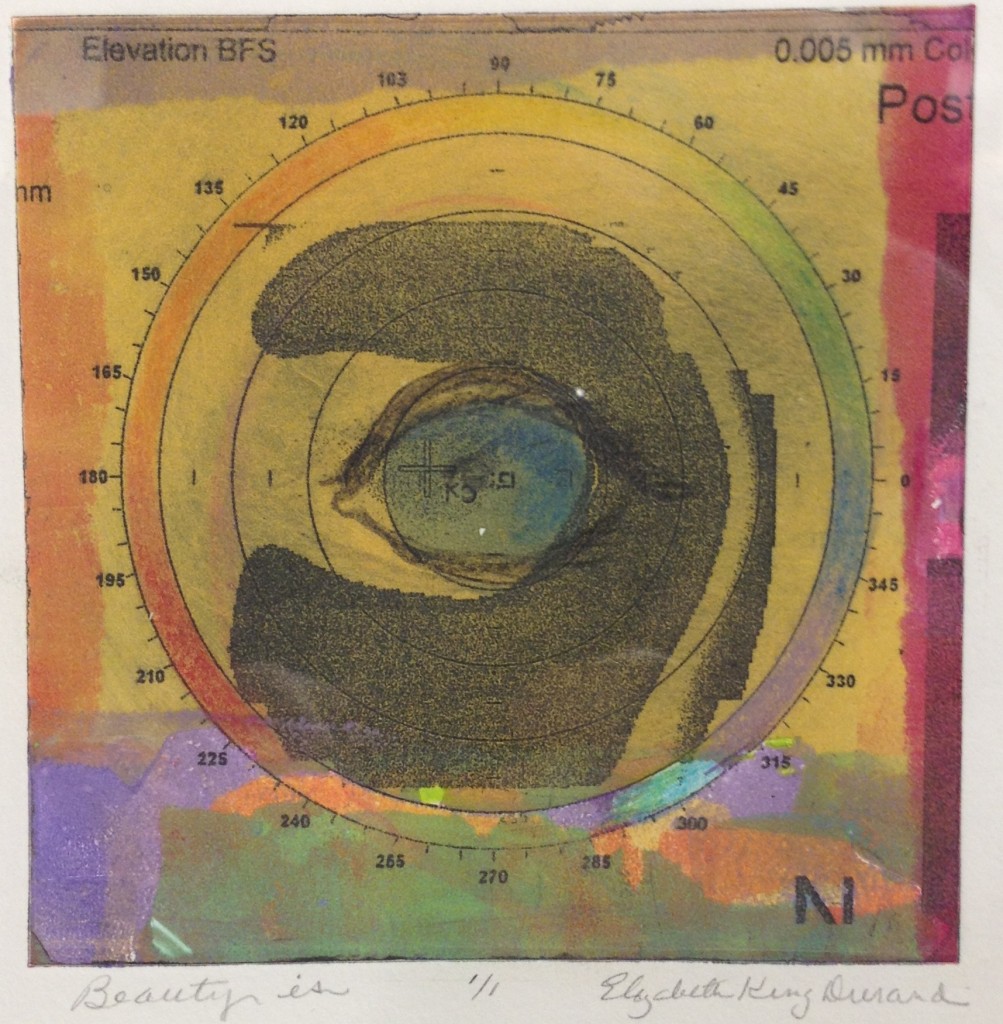 This wonderful print, Beauty is, by Elizabeth King Durand can be seen at a surprisingly colorful group show at Oxford Gallery, Proverbs and Commonplaces: all work based on sayings, a theme that presented itself to Jim Hall while he was reading a book about Bruegel. It’s a fascinating show and most of the work stands on its own, with the link to the saying offering an added layer of interest. King colored this monoprint by asking her technician for a copy of an X-ray taken for her cataract surgery. She was refused, but persisted with the surgeon who relented and printed it out for her. Her muted color sense is always full of elusive feeling.
This wonderful print, Beauty is, by Elizabeth King Durand can be seen at a surprisingly colorful group show at Oxford Gallery, Proverbs and Commonplaces: all work based on sayings, a theme that presented itself to Jim Hall while he was reading a book about Bruegel. It’s a fascinating show and most of the work stands on its own, with the link to the saying offering an added layer of interest. King colored this monoprint by asking her technician for a copy of an X-ray taken for her cataract surgery. She was refused, but persisted with the surgeon who relented and printed it out for her. Her muted color sense is always full of elusive feeling.
May 11th, 2014 by dave dorsey
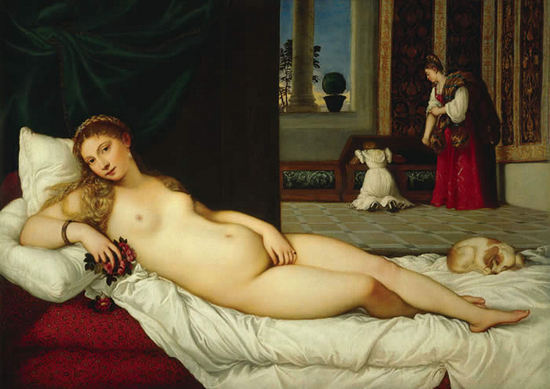
The Venus of Urbino, Titian
Great, funny piece from Huffington on how the Old Masters might have indulged in some obscurantist theorizing about their own work in order to be taken seriously, had they been contending with a postmodern academy. Sample from a contemporary Titian:
“Woman, goddess, subject, object and signifier: Venus activates both the Utopian and Dystopian spaces of the Venetian Palazzo. By inducing an affirmative valence of feminine/objective lucidity Venus poses a question: has our tendency to privatize desire further affirmed or disenfranchised her archetypal significance?”
The post concludes beautifully with:
“Life etches itself onto our faces as we grow older, showing our violence, excesses or kindnesses.”
– Rembrandt Van Rijn
That is what an actual artist’s statement sounds like…
May 9th, 2014 by dave dorsey
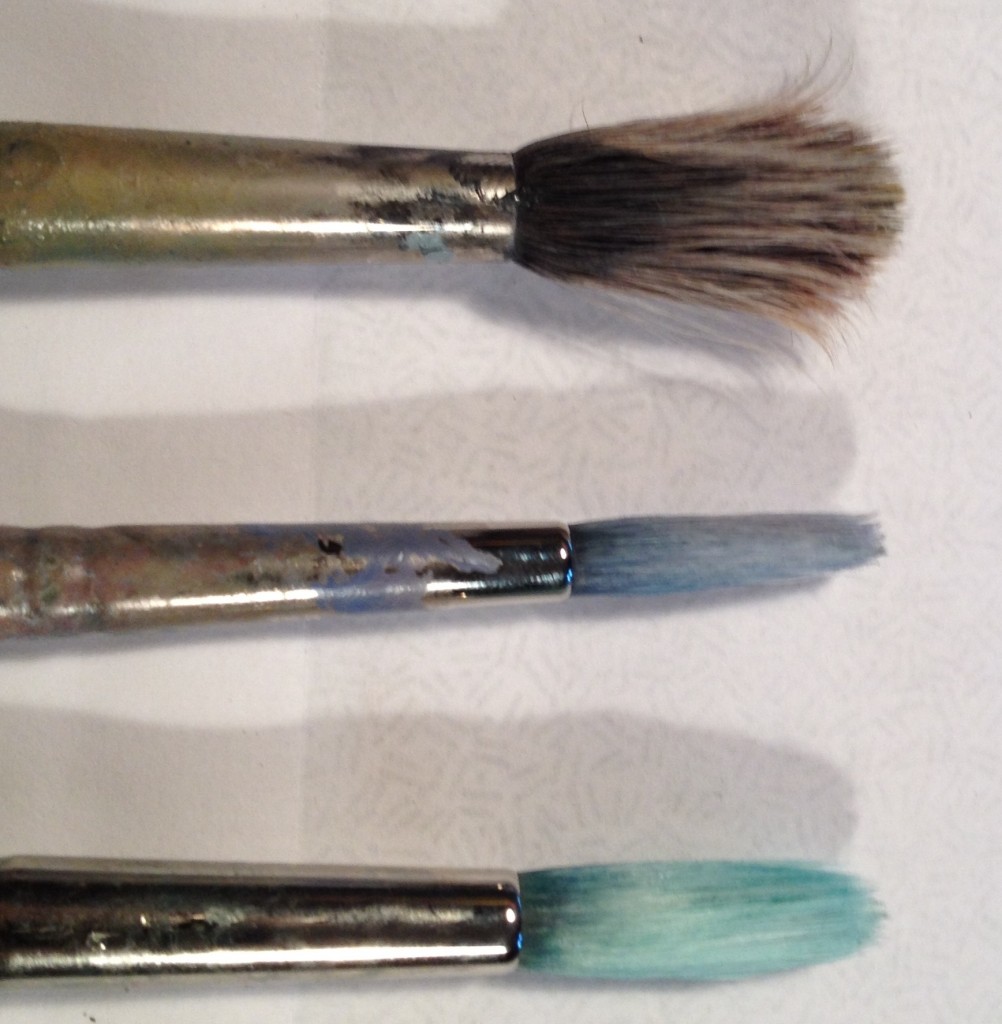
From top down: before, and then after, after
And now, the studio equivalent of a Hint from Heloise. I was ready to toss out half a dozen brushes. I have always gone through them much faster than I should mostly because it seems the more I clean them, the gummier and more fly-away they get. (Is that a hair marketing metaphor? It’s synthetic sable, so . . .) I was at the utility sink washing them the usual way, linseed oil, turpentine, and then laundry soap, and because of a recent rug cleaning effort I thought of the granular Oxiclean in our laundry room cupboard. We have one of those tubs of it that reminds me of a gallon of Breyer’s ice cream, though I’ve found the nutritional content is a bit different. I dissolved some of the granules in a little jar and then stuck my brushes in it for a few hours. When I pulled them out, they were as close to new as I’ve ever seen a used brush get. It even dissolved the paint from the metal stem holding the hairs in place. My thought: all these years, and I’ve never tried this stuff before? I’m interested in seeing how the brushes work now when loaded with paint. The bottom two brushes in the photo above looked exactly like the top one before the Oxiclean. They’re soft now. This message was brought to you by me, not Oxiclean.
May 7th, 2014 by dave dorsey
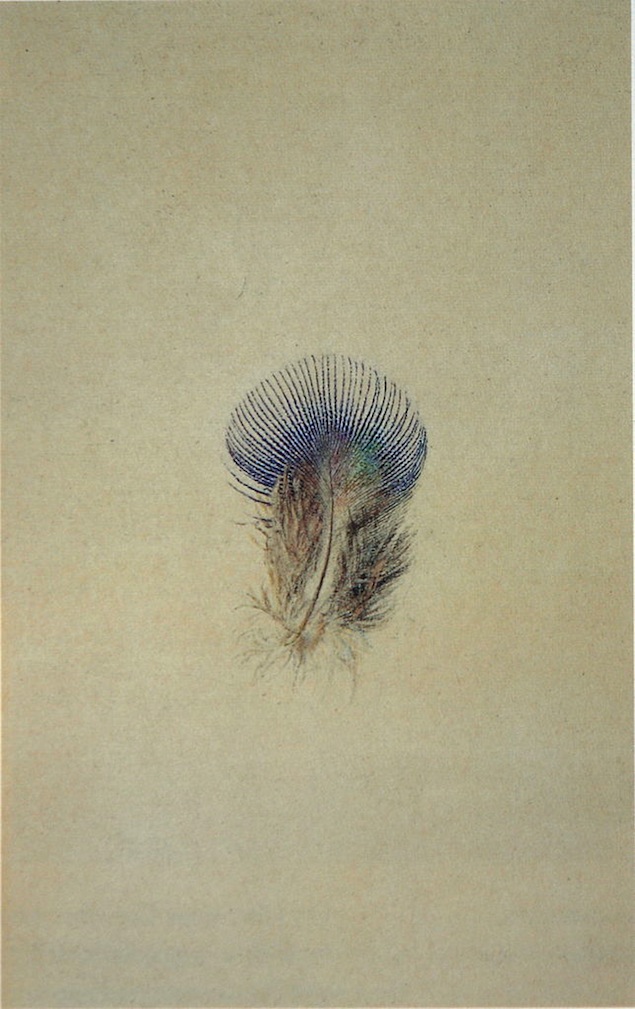
Ruskin’s drawing of a peacock feather
From Alain de Botton: “So he slowed things down and recommended we spend far longer looking at impressive things, even quite simple things. His own drawings showed the way.”





















